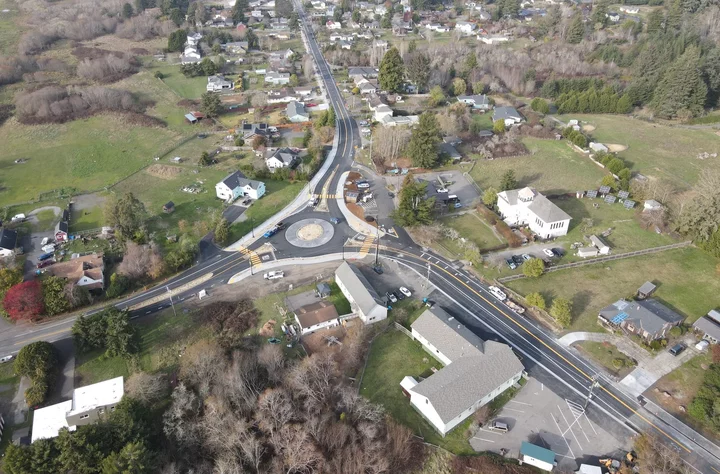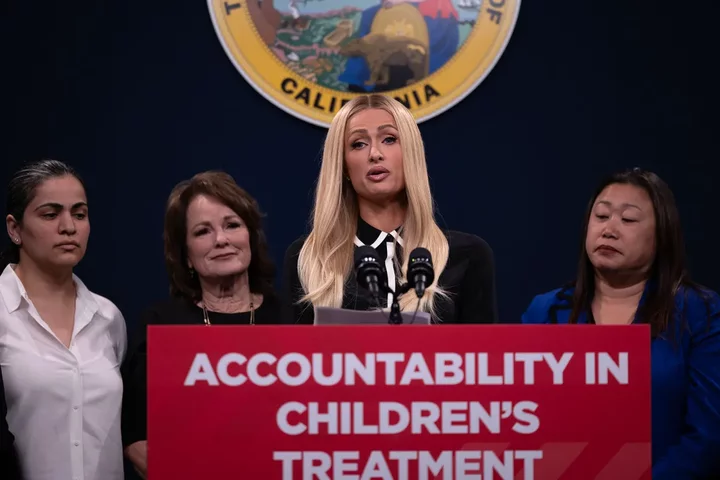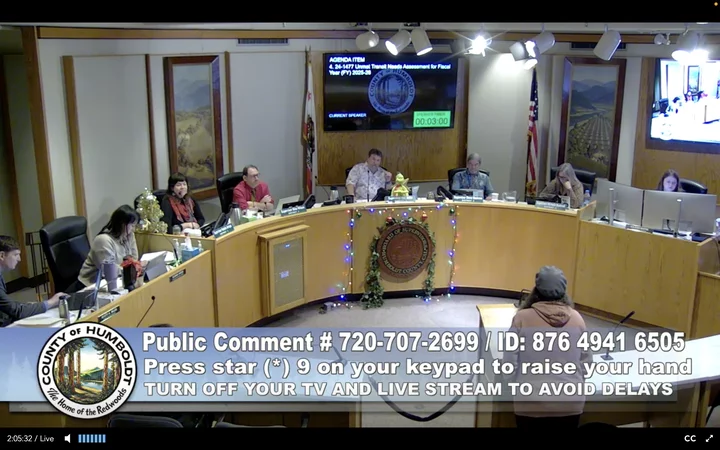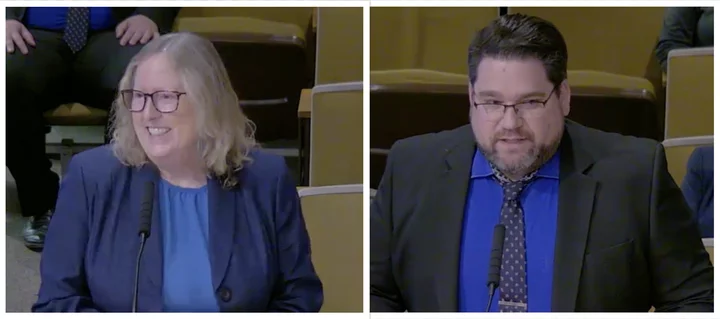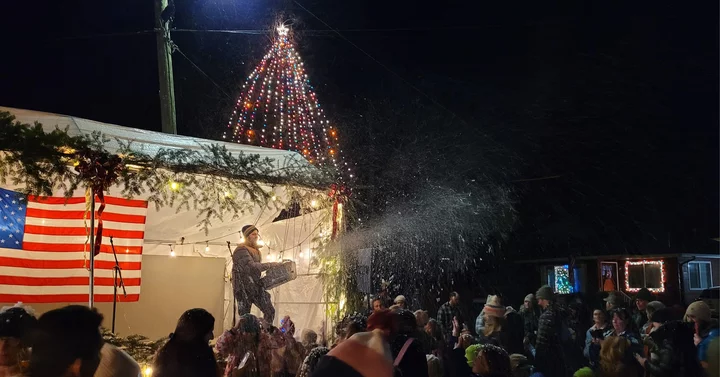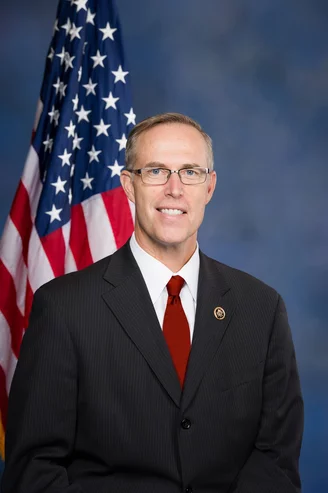GUEST OPINION: The Newly Constructed Old Arcata Road Roundabout is Finally Complete and ‘It Is Marvelous’
Paul Nicholson / Wednesday, Dec. 18, 2024 @ 10:08 a.m. / Guest Opinion
An aerial view of the newly completed roundabout at the intersection of Old Arcata and Jacoby Creek roads. | Photo: City of Arcata
###
IT IS FINALLY DONE!!!!
The construction project from Jacoby Creek Road to Sunnybrae is now complete (except for a few minor items) and it is marvelous. There is now sidewalk all the way and bike lanes on both sides with crosswalks and flashing crossing signs. There is also added parking across from the Grange, which was necessary because when there were events, traffic would park on both sides of the road and it would be down to one lane. The drainage ditch had underground culverts installed with pavers on top so it is safer to park, ride a bike and walk. Riding my bike to Sunnybrae used to feel like I was riding over train tracks. It is so smooth now.
Before the Jacoby Creek roundabout, people would be driving on Old Arcata Road towards Jacoby Creek School up to 48 miles per hour in the 25 mph zone. I was able to verify the speed because there was a radar speed sign as one would approach the school. Now, the traffic is much safer for all people in a car, on a bike or walking. There are still a few problems but they are minimal compared to the improvements that were made!
Now I would like to discuss the elephant in the room! It is particularly sad how the work crew from GR Sundberg was treated by the vehicle drivers. I heard stories about people yelling, cussing and spitting on them. The vehicle drivers would also ignore the flaggers by driving right past them, almost hitting them.
What was particularly sad was that adults with children in the car were displaying such horrible behavior and teaching the children that it was the way to handle a situation. Imagine if those adults saw their children being talked to like they talked to the flaggers and workers. Would they object to that treatment? Adults, please set an example and stop what is becoming common practice in today’s society. It was only a few and you know who you are!
People serve us every day no matter where we go. We need them to be there or we would not be able to get what we need. We don’t know what people are going through in their lives. One worker at the site opened up to me that he had cancer and has a port for his infusions. I said I wanted to write a letter to the editor and asked if I could mention his situation and he said, yes. We don’t know their financial, physical or emotional struggles they have just to serve us. I told the worker I make it a goal of mine to make someone smile every day and am particularly kind to those who serve me. I say “Thank You For Working” and smile. I hope I change someone’s attitude every day. Please help to pass a smile on to others. You may be the only positive interaction they have that day and it will mean a lot.
Paul Nicholson
Bayside
BOOKED
Today: 0 felonies, 3 misdemeanors, 0 infractions
JUDGED
Humboldt County Superior Court Calendar: Today
CHP REPORTS
3700 Mm101 N Hum 37.00 (HM office): Hit and Run No Injuries
7786 - 8198 Tompkins Hill Rd (HM office): Trfc Collision-Unkn Inj
0 Dalitz (HM office): Trfc Collision-1141 Enrt
ELSEWHERE
RHBB: Dump Trailer Loaded with Boulders Overturns on SR-20, Blocking Westbound Lane
RHBB: Dump Truck Crash Near Wolverton Gulch in Fortuna Area Ejects Occupant
Governor’s Office: California continues to lead the nation in fusion energy, investing in technology of the future
KINS’s Talk Shop: Talkshop December 15th, 2025 – John Dalby
BRING THE NOISE! The Victory Parade for Your Arcata High Football State Champs Rides This Afternoon
Ryan Burns / Wednesday, Dec. 18, 2024 @ 9:46 a.m. / LoCO Sports!
###
If you’re anywhere near Arcata and can spare some time this afternoon, you may want to make your way down to the parade route, fill your lungs with air and make some noise for the Arcata High School football team and its stalwart cheerleader squad, who will be celebrating Saturday’s nail-biter, overtime victory in the state championship game with a procession through town.
The parade will commence from Arcata High’s campus at 1:30 p.m., proceed along 16th Street to H and then down to the plaza for a victory lap before returning to campus.
It has been a remarkable season for this Tigers squad, which won the school’s first-ever North Coast Section championship, first-ever NorCal Regional crown and first-ever Division 6-AA state championship by defeating Portola in SoCal over the weekend.
Biden Administration Approves California Electric Car Mandate
Alejandro Lazo / Wednesday, Dec. 18, 2024 @ 7:48 a.m. / Sacramento
A car is charged at an Electrify America charging station in El Centro. The US EPA today authorized California’s zero-emission car mandate that phases out gas-powered cars. Photo by Adriana Heldiz, CalMatters
The Biden administration today approved California’s groundbreaking mandate phasing out new gas-powered cars just weeks before the incoming Trump administration poses a threat of overturning electric vehicle and climate rules.
The granting of the waiver by the U.S. Environmental Protection Agency allows California to move forward in requiring 35% of new 2026 model cars sold in the state to be zero-emissions, 68% in 2030 and 100% in 2035.
The EPA also today gave the go-ahead to a 2020 California regulation requiring reductions in nitrogen oxides — a key ingredient of smog — emitted by heavy-duty trucks and buses.
The Trump administration is likely to challenge the approved waivers through the courts and deny other California vehicle standards yet to be greenlit.
At a campaign event in Michigan earlier this year, Trump dismissed the possibility of any state banning new gas-powered cars, declaring, “I guarantee it — no way.”
For longer than half a century, California’s vehicle emissions rules have been the driving force for dramatic improvements in the state’s air quality, especially in the smoggy Los Angeles basin and San Joaquin Valley. Cars, trucks and other vehicles are the biggest sources of smog-forming gases and soot, which cause asthma and heart attacks and other serious respiratory problems.
“California has longstanding authority to request waivers from EPA to protect its residents from dangerous air pollution coming from mobile sources like cars and trucks,” EPA Administrator Michael S. Regan said in a statement. “Today’s actions follow through on EPA’s commitment to partner with states to reduce emissions and act on the threat of climate change.”
Congress granted California the authority to set its own vehicle emissions standards in a 1967 clean-air law. But each standard set by California requires a waiver from the EPA before it can be implemented.
“California has longstanding authority to request waivers from EPA to protect its residents from dangerous air pollution coming from mobile sources like cars and trucks.”
— EPA Administrator Michael S. Regan
Under the federal Clean Air Act, the EPA can only legally reject a waiver if it’s “arbitrary or capricious,” unnecessary for addressing air pollution or technologically infeasible due to inadequate lead time.
None of EPA waivers to California has ever been revoked. But the Trump administration in 2019 attempted to revoke one that the Obama administration granted for California’s 2012 zero-emission car mandate. The Biden administration, however, reinstated it in 2022, which has triggered lawsuits by oil companies and Republican-led states.
The stakes are high since the state’s air pollution ranks among the nation’s worst. Failure to meet federal health standards for smog and soot could result in economic sanctions, including the loss of highway funds.
“This might read like checking a bureaucratic box, but EPA’s approval is a critical step forward in protecting our lungs from pollution and our wallets from the expenses of combustion fuels,” Paul Cort, an attorney with the environmental group Earthjustice, said in a statement. “The gradual shift in car sales to zero-emissions models will cut smog and household costs while growing California’s clean energy workforce.”

A Hyundai Ioniq 6 charges at an Electrify America charging station in Oakland. Under California’s mandate, 100% of new car sales must be emissions-free in 2035. Photo by Camille Cohen for CalMatters
The Newsom administration has been pressing the EPA this year to approve all eight California clean-vehicle rules that still needed the agency’s go-ahead. Gov. Gavin Newsom traveled to Washington, D.C. last month to press the Biden administration to act before Donald Trump takes over the White House on Jan. 20.
“Clean cars are here to stay,” Newsom said in a statement. “Automakers and manufacturers have made it clear they intend to stick with California and consumers as we move toward clean cars that save people money. Naysayers like President-elect Trump would prefer to side with the oil industry over consumers and American automakers, but California will continue fostering new innovations in the market.”
Nevertheless, the transition to electrify transportation faces headwinds even in the Golden State. Electric car sales, once surging, have plateaued this year. Sales through the first nine months of this year were up only 1.2% over the same period last year, according to state data. That compares to a 56% increase in sales the previous year and 38% in 2022.
The November election has already influenced some decision-making at The California Air Resources Board, which enacts the state’s air pollution and climate rules. Earlier this month, the board at the last minute pulled back a proposed rule ramping up sales of zero-emission motorcycles. That decision came in part due to Trump’s election, a person familiar with the board’s thinking said. The state will instead offer incentives for people to buy electric motorcycles.
The EPA still is considering six other California clean air rules, including ones that phase out diesel trucks and require cleaner locomotives, commercial ships and off-road diesel vehicles like tractors and construction equipment. The most controversial are the regulations for trucks and locomotives.
Last week, the U.S. Supreme Court decided to review whether the oil industry has the legal standing to try to overturn a lower court’s decision that allowed California to set low- and zero-car emission standards for model years 2015 through 2025.
The new waivers approved today could provide more opportunities for legal disputes in the Trump 2.0 era. Those battles could once again reach the conservative-leaning Supreme Court. The justices earlier this year did away with a 40-year-old judicial rule of thumb, known as “Chevron deference,” which has been key for setting climate and environmental policy. The principle, rooted in a 1984 decision, obligated judges to yield to a federal agency’s interpretation when determining how a Congressional law should be applied.
Congress has passed little direct legislation on climate change and the EPA has relied on interpretations of older environmental laws, including the Clean Air Act.
Efforts to overturn California’s authority may also extend to Congress. The Congressional Review Act allows Congress to revoke federal rules approved during a certain timeframe at the end of an administration. Legal experts, however, debate whether that law would apply to EPA actions related to California’s clean-air waivers.
Republicans may attempt to repeal the Clean Air Act provisions that empower California, but such efforts would likely encounter resistance, including potential Democratic filibusters. Historically, bipartisan support for combating air pollution has thwarted similar moves to alter the Clean Air Act.
California’s clean-car mandate is also central to its climate strategy and has helped make the state a national leader in climate policy, with 11 states and Washington, D.C., adopting or planning to adopt its zero-emission car sales mandate.
The state’s history and economic influence also position it as a formidable opponent. Many automakers, aware of California’s large market share, have opted to negotiate with the state rather than resist. In 2020 BMW, Ford, Honda, Volkswagen and Volvo agreed to adhere to California’s standards through 2026, irrespective of federal actions. Stellantis pledged compliance with zero-emission car sales requirements through 2030, even in the face of federal or judicial opposition.
For 2026 models, 35% of sales in California must be zero emissions under the state rules; through September, they are only 25.4% of sales this year.
The phased-in mandate allows sales of new plug-in hybrids as well as battery-only cars, and the state says some gas-powered cars are expected to remain on California roads for more than 25 years.
Many obstacles stand in the way of electrifying cars, including the need for more public fast chargers. State officials estimate that California needs a million public charging stations in six years — almost 10 times more than the number available to drivers a year ago — and 2.1 million by 2035.
The Alliance for Automotive Innovation, an industry group, published a memo last week saying that it “will take a miracle” for all of the states that follow California’s rules to reach 100% new zero-emission cars by 2035.
“There needs to be balance and some states should exit the program,” the automakers said.
###
CalMatters.org is a nonprofit, nonpartisan media venture explaining California policies and politics.
Troubled California Teens Gain Protections Under a New Law Championed by Paris Hilton
Lynn La / Wednesday, Dec. 18, 2024 @ 7:42 a.m. / Sacramento
Flanked by legislators, Paris Hilton speaks in support of Senate Bill 1043 during a press conference at the Capitol Annex Swing Space on April 15, 2024. Photo by Miguel Gutierrez Jr., CalMatters
Beginning Jan. 1, hundreds of state-licensed residential treatment centers for children and youth up to age 21 operating in California must comply with a new law that brings greater transparency — particularly when they use restraints and seclusion rooms.
After restraining a youth, or putting them in a seclusion room, the facility is required to provide a report to both the youth and to their parent or guardian. The report must include a description of the incident; which staff members were involved; the rationale behind their actions; how long the incident lasted; and other details.
A copy of the report must be provided to the California Department of Social Services within seven days. The department is required to review reported incidents for any health and safety violations and, if needed, investigate the incident.
Another provision of the law, requiring the department to make data about these incidents publicly available on its website, doesn’t take effect until Jan. 1, 2026. Then, parents or guardians weighing the difficult decision to send their children to these facilities can access information about any potential misuse of restraints and seclusion rooms.
One of the most widely-recognized champions of the bipartisan measure as it advanced through the Legislature was Paris Hilton. In April, the hotel heiress, socialite and media personality visited the state Capitol to advocate on behalf of the legislation, and recount the physical and emotional abuse she experienced while living at youth treatment centers in California and other states.
A vocal critic of the “troubled teen industry,” Hilton praised the passage of the law in August.
“For too long, these facilities have operated without adequate oversight, leaving vulnerable youth at risk,” Hilton said in a statement. “I hope our state is the standard for transparency and accountability in these facilities moving forward.”
In 2021, California prohibited sending troubled youth, including foster children, to out-of-state, for-profit treatment centers after reports of rampant abuse. As an alternative, youths can be sent to short-term therapeutic facilities licensed by the state’s social services department. A year later, California passed a law to fund crisis residential treatment facilities for children on Medi-Cal.
###
CalMatters.org is a nonprofit, nonpartisan media venture explaining California policies and politics.
TODAY in SUPES: County Budget Outlook Slightly Less Dismal Than Expected, Though $15M Structural Deficit Persists
Ryan Burns / Tuesday, Dec. 17, 2024 @ 4:38 p.m. / Local Government
A festive Humboldt County Board of Supervisors. | Screenshot.
###
In its final meeting of the year, just eight days before Christmas, the Humboldt County Board of Supervisors received the gift of a silver lining on the dark economic cloud that has descended over the county budget over the past couple of years.
Delivering the county’s first quarter budget update for the current 2024-25 fiscal year, Deputy County Administrative Officer Jessica Maciel delivered a bit of good news as well as some bad. The good: The county appears to have ended fiscal year 2023-24 with roughly $42.8 million balance in its General Fund, which is a whopping $13.2 million more than what had been projected.
We say “appears” because the Auditor-Controller’s Office is still working to catch up on what had become an enormous backlog. It has yet to comple the 2022-23 financial audit or close the books on fiscal year 2023-24, so Maciel warned that the fund balances she was presenting could still change some as the figures are tallied.
The county managed to cut into its projected deficit via one-time revenues, such as earned interest on its cost plan, and various departmental efforts to save money, including through programs such as a voluntary separation incentive program and the county’s ongoing hiring freeze.
The bad news? The county is still projecting a structural budget deficit of more than $15 million for this current fiscal year. At that rate, the General Fund will run out of money in less than two years.
Other fund balances are running in the negative, Maciel said. For example, the Department of Health and Human Services (DHHS) ended fiscal year 2023-24 $16.3 million in the hole, $10 million deeper than the previous year. Maciel explained that this caused the county to lose $664,863 in interest.
She also said that DHHS expects to eventually turn things around and start operating in the black again, though such large ships take a while to turn around. The department expects to continue losing money until fiscal year 2028-29.
The county’s Road Fund, meanwhile, ended the fiscal year $7.4 million in the negative.
“[A]s you all know,” Maciel said, “disasters have decimated [the county Roads Division’s] ability to maintain roads in the county, [but] the passage of Measure O will allow them to begin to complete a backlog of road maintenance.” (Passed by voters last month, Measure O is a 1 percent sales tax measure expected to generate $24 million a year for the county.)
Wrapping up her presentation, Maciel said county staff expects to have nearly $15.9 million in available the General Fund balance after covering next fiscal year’s losses, though she added, “It’s critical that we proceed with caution” in an effort to resolve the structural deficit.
In response to the report, Fourth District Supervisor Natalie Arroyo said, “I am pleased, of course, that the outlook is better than we initially projected,” though she acknowledged the looming specter of the structural deficit.
“We’ve just got to keep our belts tight and keep forging forward and doing the best we can,” Fifth District Supervisor Steve Madrone said.
Second District Supervisor Michelle Bushnell joined in the chorus of cautionary warnings, saying, “Although it looks healthy [this budget update], it’s really not.” The trajectory toward a zero balance in the General Fund is “pretty scary,” she said.
First District Supervisor and Board Chair Rex Bohn said that the budget cuts and denials of funding requests are always painful, though he added, “This happens every 12 to 16 years. We get a couple years like this. But the thing is, we’re resilient. We come out of it.”
The staff report on the budget update also mentions an x-factor in efforts to project the fiscal future, though not by name: the re-election of Donald J. Trump.
“The change in federal leadership could have significant impact on the economy and the county budget,” the report says. “It is not yet known how these changes will impact Humboldt County. The county may need to adapt quickly.”
The board accepted the budget update report unanimously.
Dillingham (left) and Evenson. | Screenshots.
Dillingham Out, Evenson In
As its last item of business for the year, the board unanimously accepted the resignation of Auditor-Controller Cheryl Dillingham, which will become effective at the end of January. And the five supervisors also accepted Dillingham’s recommendation to appoint her deputy, Mychal Evenson, as interim A-C for the duration of her term, which runs through 2026.
The vote on those matters only took place after supervisors and staff (plus one former county administrative officer, Phillip Smith-Hanes, who called in from his current home in Kansas) were given ample opportunity to voice appreciation for Dillingham, who came out of retirement to run against former Auditor-Controller Karen Paz Dominguez.
“She has really done a phenomenal job getting us caught back up,” County Administrative Officer Elishia Hayes said. “This is why Jessica [Maciel] can present to you the budget presentation that she just did.”
Bohn through some shade on her predecessor, telling Dillingham that he is “fully aware that we’re not out of the situation that was created for us, but you’ve got us on a path [where] the state isn’t mad at us anymore, and we can actually make decipherable financial decisions.”
He added, “I have a lot better relationship with our current auditor-controller than I had with the last one.”
The other supervisors expressed gratitude as well, and they welcomed her endorsement of Evenson. In addition to lauding his accounting bona-fides, Arroyo said, “He has the voice of an angel. He can sing some fantastic light opera in addition to [his] other talents.”
Dillingham said she’ll be available to work part time and offer extra help, should the county need it, but added, “I feel that the county’s changed a lot in the 30-plus years that I’ve worked for it, and it’s time for a younger, newer generation to take it forward from here.”
Evenson added his own appreciation for his boss, saying, “She really shouldered a major burden and did something she didn’t have to do for the entire community, and it benefited the community. I think we all, everybody in Humboldt County, owes Cheryl a huge debt of gratitude.”
Evenson also noted a drastic improvement in the Auditor-Controller Department’s communications with other county departments, the community and outside agencies such as special districts.
“People reach out to us now; they communicate with us; they ask us questions. We answer them,” he said. “Everything is collaborative. We work toward solving problems, not just decreeing what to do. And it has been my pleasure to help build that environment, and I would love to continue doing it moving forward.”
FERNDALE FIRES BACK! ‘Redwood Trees are not Christmas Trees’ Says 4-H Group in Response to Zoo’s Foolhardy Tall-Tree Declaration
Hank Sims / Tuesday, Dec. 17, 2024 @ 2:46 p.m. / Our Culture
Good holiday fun with a minimum of smack-talk at this year’s lighting ceremony. Photo: Ferndale 4-H.
###
###
It is ON!
As should have been predicted, the backlash to last week’s bold declaration, by the Sequoia Park Zoo, that the Eureka institution now possessed the tallest living, lighted Christmas tree in the world, has been swift and fierce.
In the first place, Mendocino County partisans quickly jumped in to declare that their lighted living Christmas tree — also a redwood, and located on private property somewhere out in the woods between Willits and Fort Bragg so that you have to pay substantial transportation fees to see it — is even taller. Much taller! Sage Alexander of the Times-Standard was kind enough to give these people voice the other day, if for some reason you care about anything Mendo says.
Closer to home, of course, is the clear target of the Sequoia Park’s tree troll: the Victorian Village of Ferndale, which has long prided itself on its big ol’ downtown spruce and the charming tradition of firing that thing up for the Christmas season. It touts itself as the home of the World’s Tallest Living Lighted Christmas tree, and a few years ago even got into quite a scrap with Couer d’Alene, Idaho over the title.
So if the Zoo thought that Ferndalians were just going to roll over and let themselves get steamrolled by their big-city cousins in Eureka, it was quite mistaken. This isn’t varsity basketball!
Today, from Ferndale 4-H, comes the reply track. In the first place, 4-H says, a redwood tree is not a Christmas tree. (4-H does not explicitly add the phrases “… obviously” or “… as any idiot could tell you,” but they are implied.)
In the second place, Ferndale’s tree is public and open to all, and they make free cookies and hot cocoa for anyone who wants to come watch them light it up.
In the third place, Ferndale honors America at this event.
In the fourth place, the Zoo, though it possesses several wonderful attractions of its own, looks like a sad loser when tries to rip off its neighbors’ traditions. Or at least that’s how I read the final paragraphs below.
Press release from the Ferndale 4-H Community Pride Project:
O Christmas Tree, O Christmas Tree
Of All the trees most lovely……
Ferndale was delighted to celebrate our 90th Christmas Tree Lighting this year. The first Tree Lighting was in 1934 at a time following the Great Depression. It was established to be a beacon of joy and hope for our Community At a time when people were struggling, jobs were scarce and living conditions difficult
This tradition has been handed down over almost 100 years to local residents, as a task to cherish.
For many years, our Ferndale 4-H Community Pride Project Group has been taking care of this most wonderful event of the year. We start planning in September. There is a long list of things to-do to make this event happen, with a lot of wonderful help from members of our local town, too.
We get busy making our lists
Checking them twice
Gotta get ready for all our visitors, naughty or nice!
We invite all who attend to sing Christmas Carols with us.
We salute our American Flag, and we invite our Boys & Girl Scout Group as an honor guard, along with our 4-H flag in the countdown to lighting our Tree.
Sometimes even Santa finds time to visit from the North Pole.
Our event is free for everyone to attend. We bake hundreds and hundreds of cookies and whisk up hot cocoa for all to enjoy, again free of charge. It is an evening of fellowship. Welcoming visitors from near and far. Sharing our beautifully lit town, twinkling with thousands of lights.
Our Humboldt County is a beautiful place to live. Traditions are important and Community support is what makes us special.
We were disappointed to see the Sequoia Park Zoo declare that they now have the Tallest Living Christmas Tree.
The Zoo has a lot of great attributes, including the lovely Skywalk, beautifully illuminated now with lights. It will attract many visitors and can be enjoyed by many local residents.
Redwood Trees are not considered Christmas Trees. We will continue to declare that we have the Tallest Living Christmas Tree. We hope the Sequoia Park Zoo can create their own title, separate from ours, with an eye to lifting up all our neighboring towns in Humboldt. We hope they can support all of our traditions, while still creating holiday magic for the community.
Each of our towns can be a beacon of Joy, Hope and Light during the Holiday season.
Merry Christmas to All And to All A Good Night.
Community Pride Project Group
Ferndale 4-HLiz Klopper - Project Leader & Co-Community Leader
Courtney Sousa - Community Pride Project Leader
Huffman Named Ranking Member of the House Natural Resources Committee
LoCO Staff / Tuesday, Dec. 17, 2024 @ 9:28 a.m. / Government
Press release from Rep. Jared Huffman’s office:
Washington, D.C. – Today, Rep. Jared Huffman (CA-02) was announced as Ranking Member of the House Natural Resources Committee for the 119th Congress.
“It is the honor of my lifetime to win this election and be named Ranking Member of the Natural Resources Committee. My entire career has been centered around natural resources – from my time as an attorney at the Natural Resources Defense Council to the past twelve years serving on this committee,” said Rep. Huffman. “I am incredibly grateful to the many partners who have supported me in my journey – tribes from around the country, environmental allies, and the overwhelming majority of my colleagues I’ve served with here in the House. I will work day-in and day-out to honor the trust they have put in me to lead this committee. We have weathered many storms together and I believe we are better prepared than ever to tackle what lies ahead next Congress. This is a team sport, and I am excited and ready to lead this team.”
Rep. Huffman is a proven and qualified leader, earning commitments from over 170 of his colleagues in this election. Huffman has served on HNRC for the past 12 years and served as a Subcommittee Chair/Ranking Member for the past 10 years. Huffman also represents a district that gives him a unique perspective and comprehensive insight on the issues reflected in Natural Resources. His district:
- Has more indigenous tribes than any district outside of Alaska;
- Includes a vast array of public lands and waters;
Experiences some of the worst impacts of the climate crisis;- Is at the forefront of innovative climate solutions.
Prior to Congress, he worked as a California legislator chairing environmental committees, an environmental attorney with the Natural Resources Defense Council, and Board President for a major municipal water district.
This announcement comes after his challenger dropped out following a 44-17 vote in the Steering and Policy Committee last night. The outpouring of support Huffman received during this race has included:
- Current and former members of the House Natural Resources Committee highlighting the importance of continuity, experience, and bold leadership for the Committee’s critical work ahead.
- 24 members of Congress who have been on the frontlines of Democrats’ toughest battles.
- Three former Chairs and Ranking Members of the Committee underscoring the deep institutional knowledge and expertise they’ve entrusted Huffman to uphold.
- 32 tribes and tribal representatives joined a letter supporting Huffman’s candidacy, and several others, including the Cow Creek Band of Umpqua Tribe of Indians, Greenville Rancheria Tribal Council, Round Valley Indian Tribes, and Mooretown Rancheria sent individual statements of support, emphasizing the critical importance of centering tribal sovereignty and the protection of cultural and sacred resources in his work.
- Endorsement letters from the Center for Biological Diversity, the Grassland Water District, Ecological Restoration Business Association, Save the Redwoods League, and CalTrout citing his leadership throughout his career fighting to uphold the nation’s bedrock environmental laws that protect public lands, air and water, and this nation’s endangered species.

